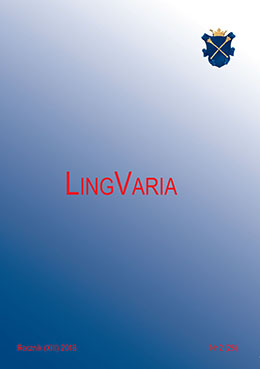O kilku możliwych śladach duale tantum w językach indoeuropejskich
DOI:
https://doi.org/10.12797/LV.13.2018.26.04Słowa kluczowe:
języki indoeuropejskie, leksyka indoeuropejska, liczba podwójna, słowotwórstwoAbstrakt
On Some Possible Traces of Duale Tantum in Indo-European Languages
The paper is devoted to three selected Indo-European nouns that can be considered as dualia tantum. On the basis of lexical data preserved in historical Indo-European languages, I have reconstructed three probable archetypes:
(1) IE. *ḱelī- (< PIE. *ḱel-ih1) f. duale tantum ‘two-component body of a human or animal’ is precisely attested in Avestan sairi f. du. tant. ‘two solid components of the human and animal body, i.e. the skin together with meat and bones; body, dead body, corpse’. The primitive dual form seems to appear in Old Indic (Vedic) śárīram n. ‘body, body frame, solid parts of the body, pl. bones’, also ‘a dead body’ (a derivative noun created by means of the suffix -ra- < IE. *-lo-), cf. also Pali sarīra- n. ‘body’, Prakrit sarira- n. ‘id.’; West Pahari sarīr, Old Gujarati saïra, sayara n. ‘body’.
(2) IE. *agu̯ sī- f. sg. ‘axe’ (< PIE. *h2egu̯ s-ih1 f. du. tant. ‘double axe, two-edged battle-axe’) can be seen not only in the Germanic languages (e.g. Gothic aqisi f. ‘axe’, Old High German acchus ‘id.’, English axe ‘id.’), but also in some Greek-Latin derivatives (see Greek ἀξῑ́νη f. ‘double axe, twoedged battle-axe’, Modern Greek αξίνα f. ‘hoe, mattock, pickaxe’, Latin ascia f. ‘axe, trowel’). The original meaning ‘double axe, two-edged item’ is firmly confirmed by the Greek data.
(3) IE. *oldhī- f. sg. ‘a kind of boat’ (< PIE. *h3eldh-ih1 f. du. tant. ‘a primitive boat built from two troughs’ ← *h3eldh- f. ‘trough’) is reflected in Tocharian AB olyi ‘boat’, Lithuanian eldijà f. ‘a canoe, a boat hollowed out from one trunk’, dial. aldijà f. ‘id.’, Old Church Slavic ladija f. ‘πλοῖον, σκάφη / navis, navicula’, also alъdija ‘id.’, Old Czech lodí f. ‘ship, boat’, Polish łódź f. ‘boat’ and so on. The basic noun *h3eldh- ‘trough’ is securely attested in the Germanic languages, cf. Norwegian alde f. ‘wooden trough’, Danish olde ‘id.’ (< Proto-Germanic *aldōn- f.).
Pobrania
Bibliografia
Abramowiczówna Z. (red.), 1958, Słownik grecko-polski, t. 1, Warszawa.
Adams D.Q., 1999, A Dictionary of Tocharian B, Amsterdam – Atlanta.
Babiniotis G., 2011 [= G. Mpampiniώthς], Etymologikό leksikό thς nέaς ellhnikής glώssaς, Athήna.
Bartholomae C., 1904, Altiranisches Wörterbuch, Strassburg.
Beekes R., 2010, Etymological Dictionary of Greek, t. 1–2, Leiden – Boston.
Bjorvand H., Lindeman F.O., 2007, Våre arveord. Etymologisk ordbok, Oslo.
Blažek V., 2014, Indo-European Nominal Inflection in Nostratic Perspective, „Journal of Language Relationship” XI, s. 19–38.
Buck C.D., 1949, A Dictionary of Selected Synonyms in the Principal Indo-European Language. A Contribution to the History of Ideas, Chicago.
Clackson J., 2007, Indo-European Linguistics. An Introduction, Cambridge.
Danka I.R., 1984, Stanowisko języków anatolijskich w rodzinie indoeuropejskiej i ich wzajemne związki, Łódź.
Derksen R., 2015, Etymological Dictionary of the Baltic Inherited Lexicon, Leiden – Boston.
Falk H.S., Torp S., 1910, Norwegisch-Dänisches etymologisches Wörterbuch, t. 1, Heidelberg.
Fraenkel E., 1962, Litauisches etymologisches Wörterbuch, t. 1, Heidelberg.
Fritz M., 2011, Der Dual im Indogermanischen. Genealogischer und typologischer Vergleich einer grammatischen Kategorie im Wandel, Heidelberg.
Jurewicz O., 2000, Słownik grecko-polski, t. 1, Warszawa.
Kowalski A.P., 2017, Kultura indoeuropejska. Antropologia wspólnot prehistorycznych, Gdańsk.
Kroonen G., 2013, Etymological Dictionary of Proto-Germanic, Leiden – Boston.
Kümmel M., Rix H. (red.), 2001, Lexikon der indogermanischen Verben. Die Wurzeln und ihre Primärstammbildungen, Wiesbaden.
Latte K., 1953, Hesychii Alexandrini Lexicon, t. 1, Hauniae.
Ledo-Lemos F.J., 2003, Femininum Genus. A Study on the Origins of the Indo-European Grammatical Gender, München.
Lewickij W.W., 2010 [= V.V. Levickij], Ètimologičeskiŭ slovarʹ germanskih âzykov, t. 1, Vіnnicâ.
Liddell H.G., Scott R., 1996, A Greek-English Lexicon with a Revised Supplement, Oxford.
Mallory J.P., Adams D.Q. (red.), 1997, Encyclopedia of Indo-European Culture, London – Chicago.
Mallory J.P., Adams D.Q., 2008, The Oxford Introduction to Proto-Indo-European and the Proto-Indo-European World, Oxford.
Mann S.E., 1984–1987, An Indo-European Comparative Dictionary, Hamburg.
Mańczak W., 2017, Polski słownik etymologiczny, Kraków.
Mayrhofer M., 1964, Kurzgefasstes etymologisches Wörterbuch des Altindischen, t. 3, Heidelberg.
Mayrhofer M., 1996, Etymologisches Wörterbuch des Altindoarischen, t. 2, Heidelberg.
Monier-Williams M., 1999, A Sanskrit-English Dictionary, Delhi.
Montanari F., 1995, Vocabolario della lingua greca, Milano.
Myznikov S.A., 2016 [= S.A. Myznikov], Dialektnaâ realiâ i leksikografičeskij konstrukt v kontekste ètimologičeskih issledovanij. Odczyt wygłoszony na międzynarodowej konferencji naukowej „Symposium Etymologicum. Śladami myśli etymologicznej (w stulecie urodzin wybitnego slawisty i etymologa Profesora Franciszka Sławskiego)”, Kraków, 25–27 maja 2016.
Orel V., 2003, A Handbook of Germanic Etymology, Leiden – Boston.
Pokorny J., 1959, Indogermanisches etymologisches Wörterbuch, Bern – München.
Rosół R., 2013, Frühe semitische Lehnwörter im Griechischen, Frankfurt am Main.
SEBor: W. Boryś, Słownik etymologiczny języka polskiego, Kraków 2005.
SESŁ: Sławski F., Słownik etymologiczny języka polskiego, t. 1–5, Kraków 1975–1982.
Shields K., 2004, The Emergence of the Dual Category in Indo-European: A „New Image” and Typological Perspective, „Indogermanische Forschungen” CIX, s. 21–30, [on-line:] https://doi.org/10.1515/16130405.21.
Smoczyński W., 2007, Słownik etymologiczny języka litewskiego, Wilno.
Torp A., Falk H., 1909, Wortschatz der germanischen Spracheinheit, Göttingen.
Trautmann R., 1923, Baltisch-Slavisches Wörterbuch, Göttingen.
Trubaczow O.N., Żurawlow A.F. (red.), 2005 [= O.N. Trubačev, A.F. Žuravlëv], Ètimologičeskiŭ slovarʹ slavânskih âzykov. Praslavânskiŭ leksičeskiŭ fond, vyp. 32, Moskwa.
Turner R.L., 1966, A Comparative Dictionary of the Indo-Aryan Languages, London.
Vaan M. de, 2008, Etymological Dictionary of Latin and the Other Italic Languages, Leiden – Boston.
Vries J. de, 1977, Altnordisches etymologisches Wörterbuch, Leiden.
Pobrania
Opublikowane
Jak cytować
Numer
Dział
Licencja
Prawa autorskie (c) 2018 Krzysztof Tomasz Witczak

Utwór dostępny jest na licencji Creative Commons Uznanie autorstwa – Użycie niekomercyjne – Bez utworów zależnych 4.0 Międzynarodowe.






